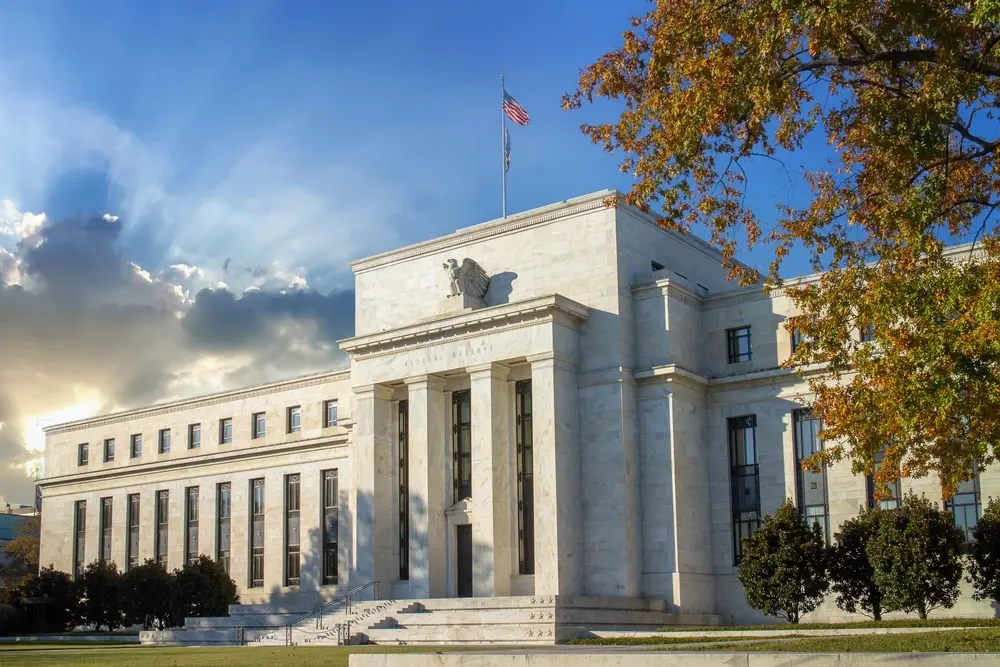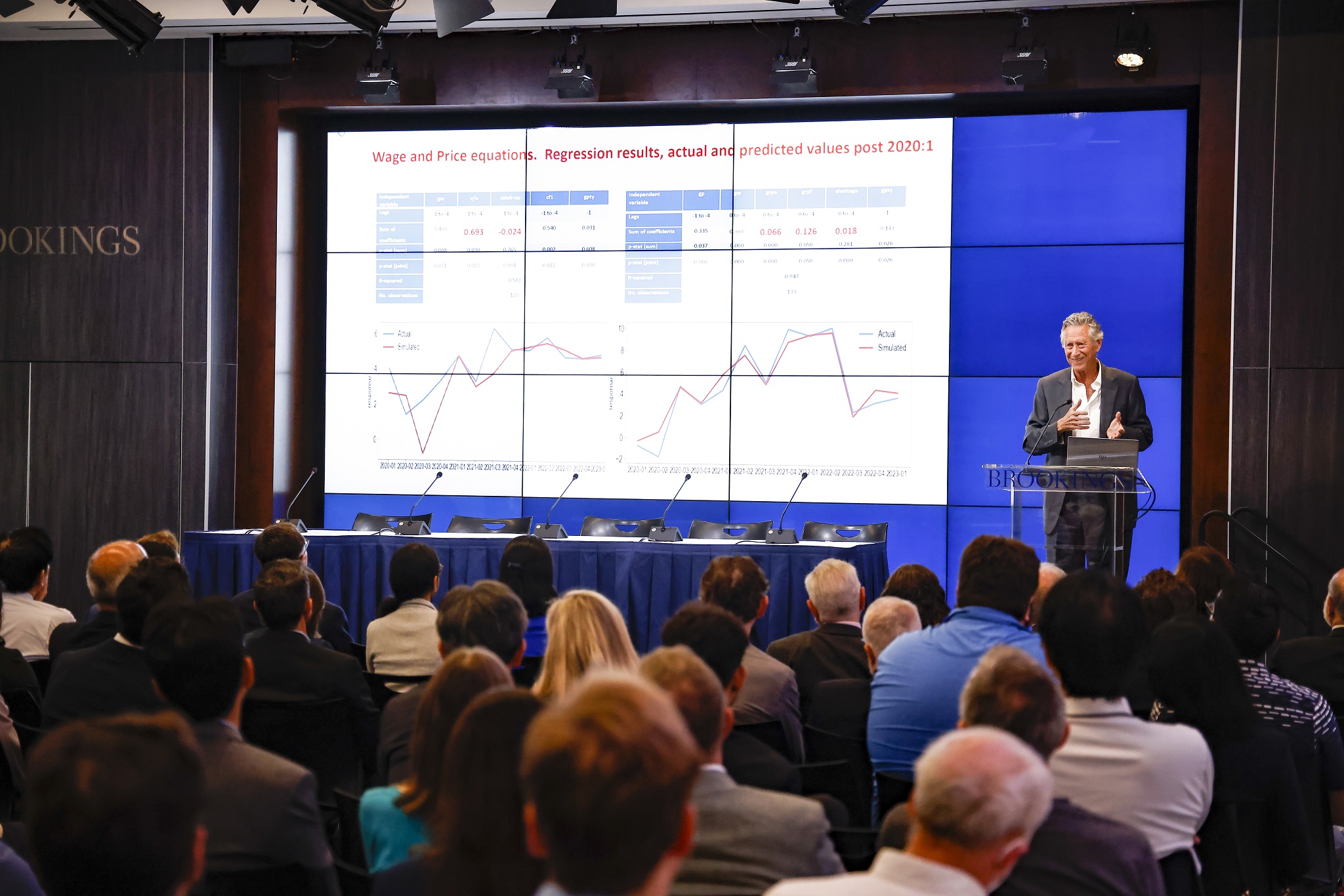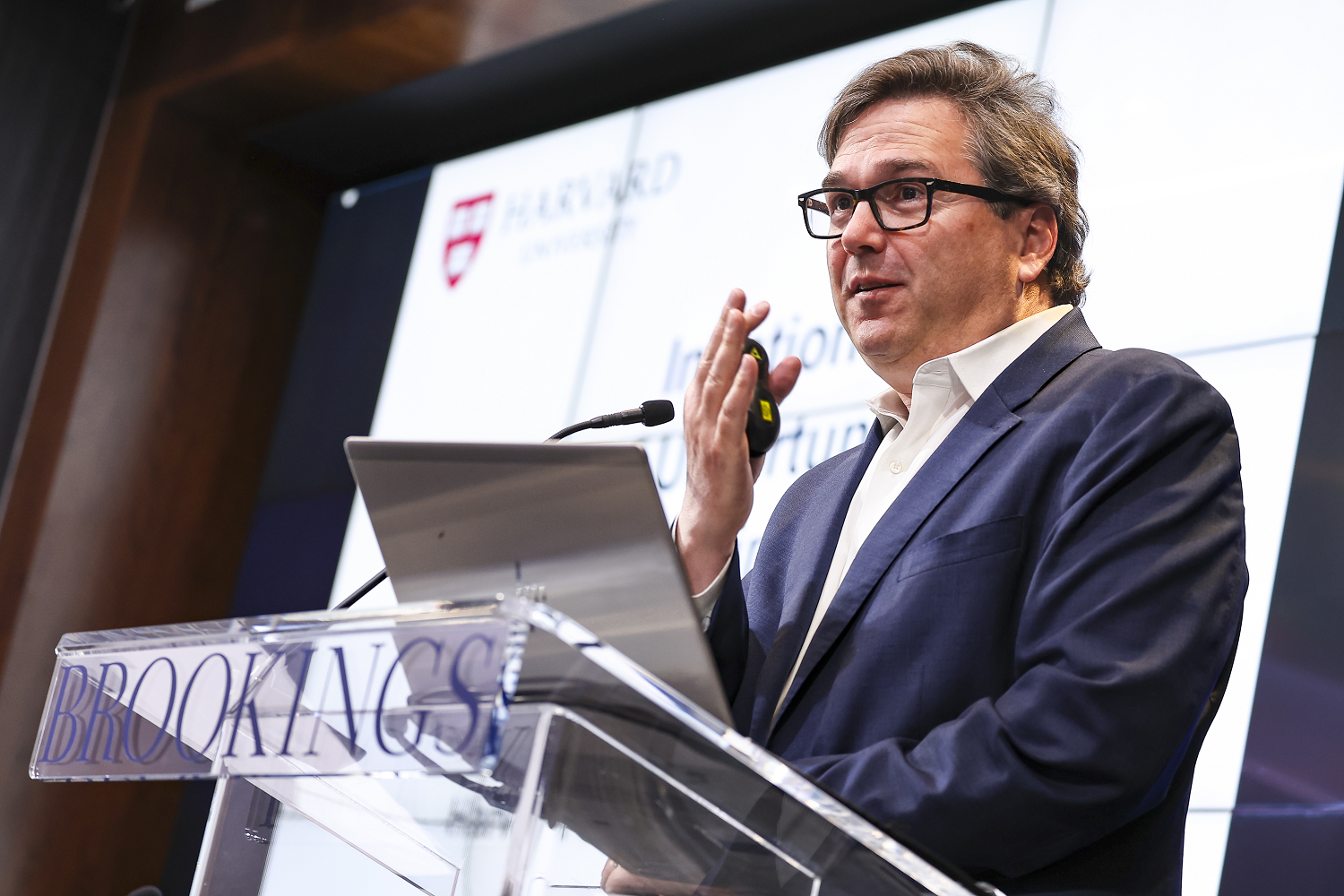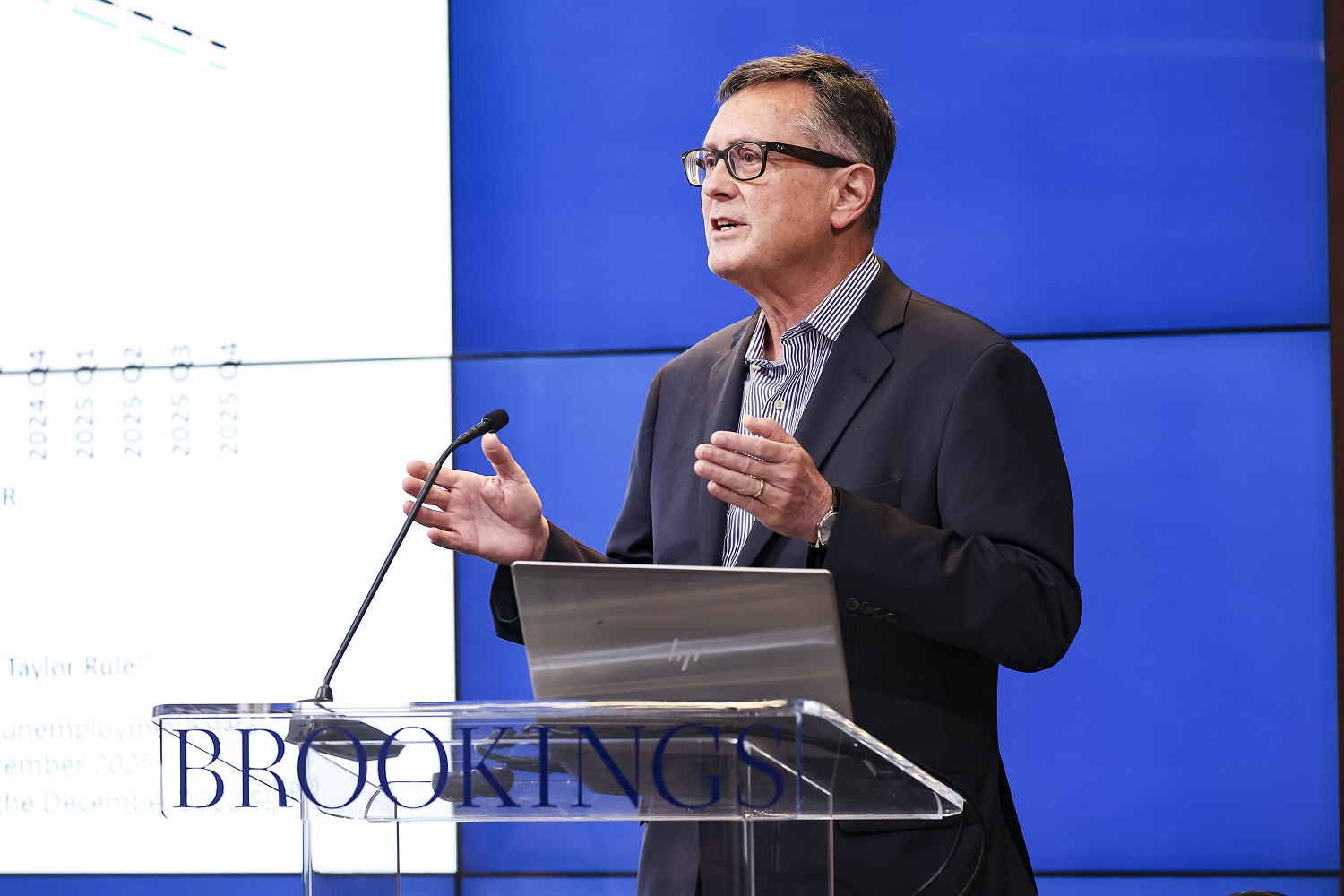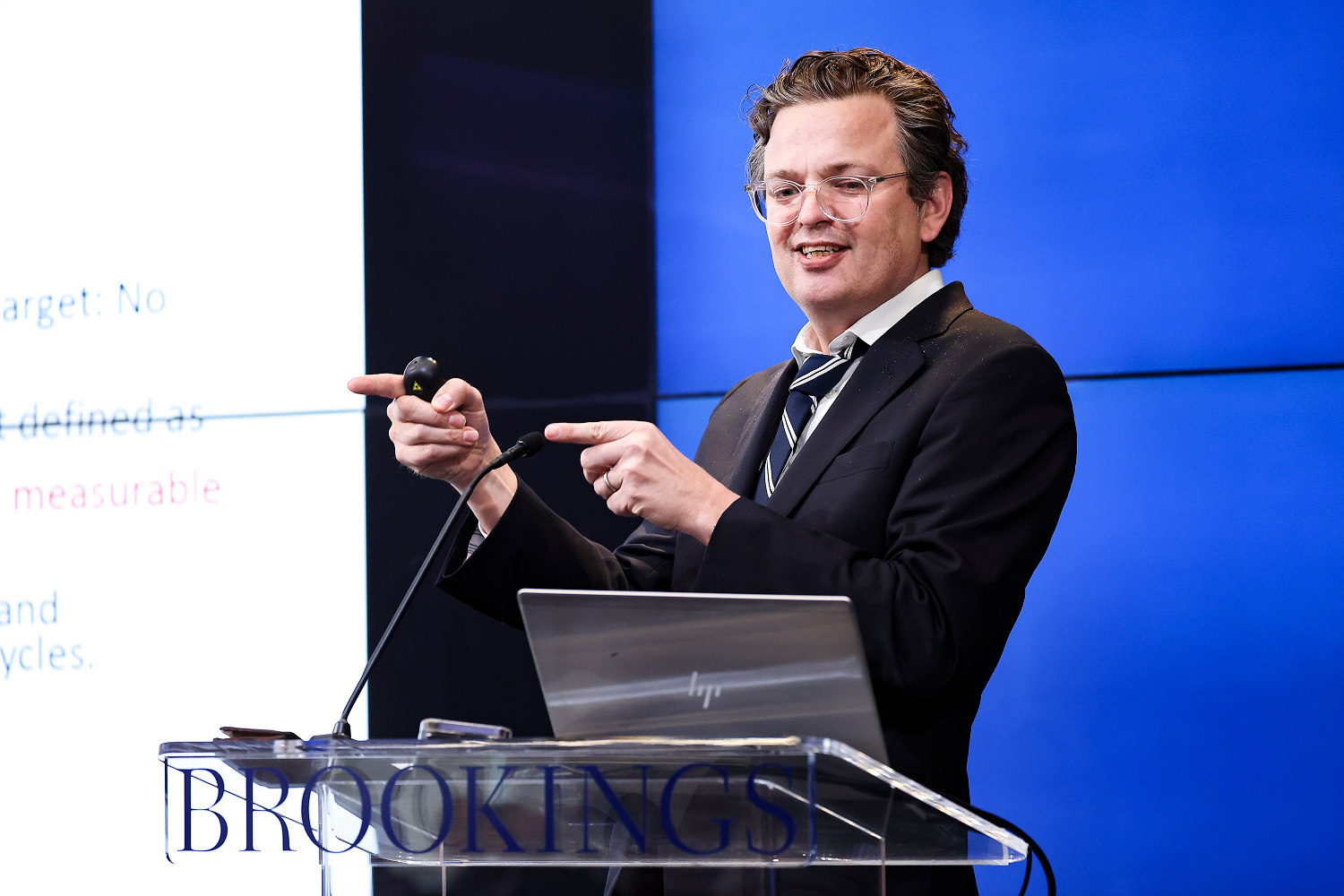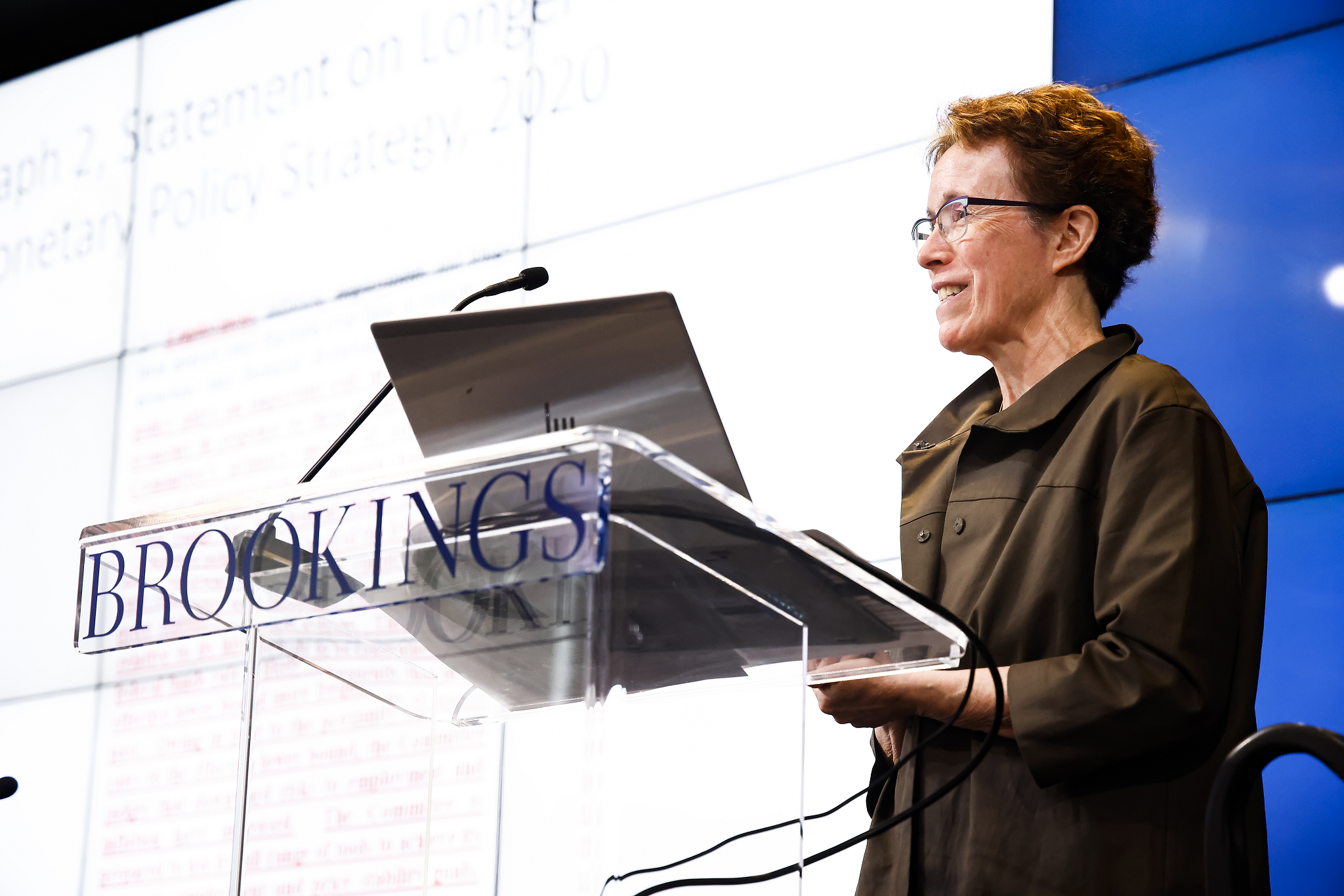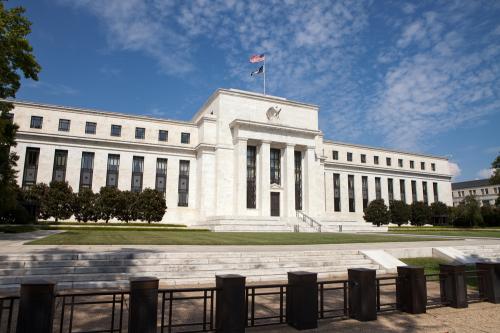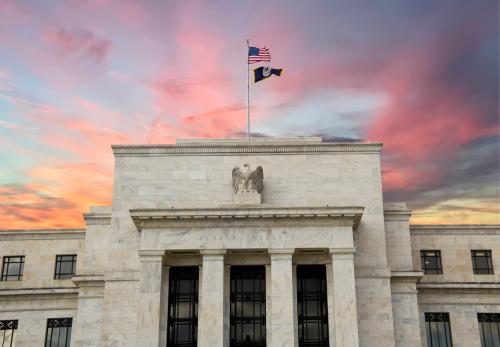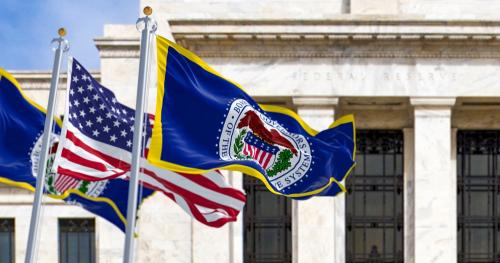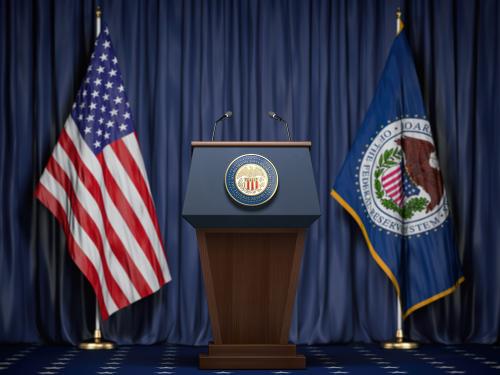When the COVID-19 pandemic hit in early 2020, the Federal Reserve moved swiftly and forcefully. It cut its short-term interest rate target nearly to zero in March 2020 and kept it there until March 2022, resumed purchasing large quantities of U.S. Treasury and government-backed mortgage bonds (“quantitative easing”), and offered “forward guidance” on the future path of short-term rates. Along with along with a large dose of fiscal policy and the spread of newly developed vaccines, the aggressive monetary policy contributed to a vigorous economic recovery, but one accompanied by an unwelcome and persistent increase in inflation. The consumer price index peaked at nearly 9%, year over year, in the summer of 2022.
The pandemic coincided with the Fed’s launch in August 2020 of a new strategy for achieving its statutory mandate of maximum employment and stable prices. The strategy included a vow to follow periods of below-2% inflation with periods in which inflation was “moderately above 2% for some time,” and to focus more on pushing employment up to its maximum sustainable level than on pulling it down in boom times. It also suggested that the Fed would avoid preemptively raising interest rates when unemployment is low unless inflation was evident.
At a May 2023 conference, the Hutchins Center on Fiscal & Monetary Policy asked: What lessons should the Fed learn from the past three years? For answers, we turned to:
- Ben Bernanke, the former Fed chair now at the Hutchins Center, and Olivier Blanchard, a former chief economist at the International Monetary Fund who is now at the Peterson Institute for International Economics. They examined the causes of the recent bout of inflation.
- Gauti Eggertsson of Brown University and Don Kohn, a former Fed vice chair now at the Hutchins Center. They critically evaluated the role of the Fed’s new framework and its forward guidance in the surge in inflation.
- Commenting were Richard Clarida of Columbia University, who, as Fed vice chair, oversaw the rewrite of the framework; Jason Furman of Harvard University, a former chair of the White House Council of Economics; Ellen Meade of Duke University, who was a senior Fed staffer during the framework rewrite, and Kristin Forbes of MIT, a former member of the Bank of England Monetary Policy Committee.
Video of the conference is posted here. This site provides the full text of the Bernanke-Blanchard and Eggertsson-Kohn papers and discussants’ remarks, as well as a summary of the conversation that followed the presentations.
Bernanke & Blanchard: What caused the U.S. pandemic-era inflation?
Bernanke and Blanchard find that many forecasters, including those at the Fed, anticipated that inflationary pressures arising from large U.S. fiscal packages would appear primarily in the labor market, as increased demand for workers put upward pressure on wages and, ultimately, on prices. However, most of the rise in inflation in 2021 and 2022 was driven by developments that directly raised prices rather than wages, such as sharp increases in global commodity prices, and sector-specific price spikes driven by a combination of pandemic-induced kinks in supply chains and a huge shift in demand from services to goods. Fiscal policy contributed to inflation, but primarily through its effects on consumer demand for commodities and goods in limited supply rather than through the labor market.
Bernanke and Blanchard argue that tight labor markets – best measured by the ratio of the number of vacancies to the number of unemployed persons – are beginning to play a more significant role in pushing up prices while the effects of commodities and sector-specific price shocks wane. Bringing inflation down to the Fed’s 2% target will require bringing the demand and supply of labor into better balance, they say. Whether that requires a significant increase in the unemployment rate from today’s historically low levels depends on the extent to which balance in the labor market can be restored by a decline in the in the unusually high number of job openings without triggering a lot of layoffs. That, in turn, depends on whether the efficiency of the labor market in matching employers and workers, disrupted during and after the pandemic, returns to pre-pandemic levels.
In response, Jason Furman questioned the Bernanke-Blanchard argument, emphasizing the big role that demand fueled by fiscal policy played in pushing up inflation, and suggesting that they put too much weight on disruptions to supply chains.
Richard Clarida noted that the sustained surge in core inflation was a global phenomenon, not just a U.S. one, and that there was much more of a correlation between fiscal policy responses to the pandemic and inflation than between monetary policy and inflation. He also argued that there were little incoming data or conventional monetary policy rules that would have called for the Fed to raise rates much earlier than it did. “Broad based price and wage inflation took off at the time when conventional metrics based on pre-pandemic experience indicated that the economy was operating below potential,” he said.
Bernanke and Blanchard respond to Furman
In response to Furman, Bernanke said that the debate is not whether inflation was the result of fiscal- and monetary-fueled aggregate demand or the result of constrained aggregate supply. Demand was an important part of the story, but not aggregate demand working through the labor market, pushing up wages, and thus pushing up prices. Supply constraints were important. He cited the example of the auto industry: Prices rose sharply, inventories collapsed, and production fell. If it had been a demand-side phenomenon, one would have expected production to go up a bit or at least stay the same. “What we were trying to do is show that these different sources of inflation – and there were multiple sources of inflation – interact with each other. For example, higher gas prices coming from higher oil prices in turn might affect people’s inflation expectations, which in turn might affect the wages that they ask their employers for, which in turn might affect the prices that the employers charge,” he said. Bernanke also observed that, contrary to Furman’s argument, if aggregate demand and aggregate supply both move up at the same pace, it’s possible to have constant output and rising prices. He cited a recent paper by Gagliardone and Gertler that argues that the main sources of the recent inflation were on the supply side, and the Fed accommodated them to avoid a recession.
Furman responded that he didn’t mean to suggest that the Bernanke-Blanchard paper implied that the recent inflation was caused by supply, not demand. His question is whether developments were completely predictable given the aggressive fiscal and monetary policy, in which case forecasters at the Fed and elsewhere should have seen this coming, or if they were caused by the Russian invasion of Ukraine, which was not foreseeable in 2021. Bernanke and Blanchard don’t answer that. He acknowledged that the auto industry is one strong example of the importance of supply constraints. On the question of nominal versus real GDP, he said his point is that if you do 10% of GDP in fiscal stimulus over two years, if real output can’t go up that much, then you get higher prices.
Regarding Furman’s question about whether all this was predictable, Blanchard quipped that the next time we get a pandemic-like shock, we’ll be ready. He said that in previous cyclical fluctuations, the assumption was that firms were on the horizontal part of the supply curve –that is, they could meet more demand with more supply. This time, we were on the vertical part of the supply curve; indeed, in some cases, the supply curve shifted back. As a result, a big demand push met an inelastic supply curve; the next time, we should identify sectors with inelastic supply curves, including commodities. But he expressed skepticism that the large fiscal expansion in the U.S. was sufficient to explain the increase in global commodity prices given that other countries didn’t have such large fiscal packages.
Was the bigger mistake fiscal or monetary?
From the audience, Brian Sack asked which was the bigger sin: too much fiscal stimulus or too much monetary stimulus. Furman was explicit: The quantitatively larger sin was fiscal policy, especially for the year 2021. The less forgivable sin, though, was monetary policy, for several reasons. The fiscal choice was basically made in January 2021, although it didn’t pass for another two months. The world was somewhat unclear at the time how much this was going to be a complete bounce back versus an economy that was still dragging. He said he has lower expectations for fiscal policy: “When they get the sign right, I am pleasantly surprised.” In contrast, the Fed made the same mistake meeting after meeting. It didn’t respond when fiscal policy was quite different from its expectations. And, he added, he has higher expectations for the Fed than just getting the sign right. But he was quick to add that the Fed caught up much faster than he expected. He suggested nothing the Fed could have done would have stopped inflation from rising, but argued that the U.S. would have less inflation today if the Fed had moved more quickly to raise interest rates in 2021
Eggertsson & Kohn: The inflation surge of the 2020s: The role of monetary policy
Eggertsson and Kohn conclude that the Fed’s revised monetary policy framework, unveiled in August 2020, elevated the importance of the “maximum employment” half of the Fed’s dual mandate and implied an inflationary bias. They see this as a reaction to the persistence of below-target inflation in the first two decades of the 2000s, a reaction that turned out to be ill-suited to the economy of the 2020s. The Fed’s forward guidance amplified the inflationary bias implicit in the framework, they argue. By saying it would not raise rates from zero until the maximum employment threshold was met, the Fed essentially put no ceiling on how high inflation would go before it tightened. The pledge to delay any rate increases until the end of asset purchases and to provide substantial advance notice of rate increases added to the inertia.
Although a prompter Fed response to building inflationary pressures wouldn’t have prevented the upturn in inflation or its persistence, Eggertsson and Kohn argue that, had the Fed moved earlier, inflation likely would not have risen so much, and the Fed might have been able to raise interest rates more gradually.
Looking ahead to the Fed’s review of its monetary policy framework, promised for 2025, Eggertsson and Kohn offer several recommendations:
- The Fed should test revisions to the framework against several, and distinctly different, scenarios. Conditions will never conform to those envisioned when the forward guidance is set, and forward guidance needs to have flexibility built in, even at the cost of some effectiveness at pinning rate expectations. The forward guidance issued by the FOMC impinged too far on the “nimbleness” required for good policymaking.
- The Fed should consider whether the hoped-for benefits of moving more aggressively when employment is below the maximum sustainable level than when it is above that level outweigh the potential costs (e.g., unwelcome inflation).
- The Fed should be prepared to alter its forward guidance when conditions warrant and should clearly explain why it is doing so.
- The Fed should not, as a rule, wait to raise rates until it completes asset purchases.
- The Fed should consider an explicit definition of maximum employment as the highest level of employment consistent over time with stable prices.
- The Fed should construct forward guidance and the policy it implies not only to achieve near-term goals, but with an eye to sustaining stable prices and maximum employment after those goals are achieved.
- Given the dearth of dissents on the FOMC in 2021 and 2022, the committee should examine whether its consensus-driven decision-making process is allowing sufficient scope for effective challenges to the majority view.
In her discussion, Ellen Meade said that the Fed’s 2020 revisions to its monetary policy strategy were specific to a particular problem – namely, the increased likelihood that the Fed’s policy rate would hit the zero lower bound. “It was not a broad articulation of goals and principles like the 2012 framework had been but narrowed the focus to a particular, very significant issue.” She agreed that the next iteration of the framework should be “robust to a broad range of scenarios,” but questioned what the authors mean when they refer to stress testing a framework, assuming a framework should be a broad statement of principles. Meade challenged Eggertsson and Kohn’s assertion that the new framework placed a new and higher priority on the employment half of the Fed’s dual mandate. She also challenged the view that the Fed effectively abandoned preemptive strikes against inflation.
Was it the framework or the forward guidance?
David Wessel, the session moderator, asked Don Kohn how much of the problem he and Eggertsson identified can be attributed to the Fed’s new framework, and how much to the forward guidance. Kohn said that the forward guidance grew out of the framework, but the forward guidance went well beyond the framework. The framework does say that the Fed won’t react to very tight labor markets merely because it anticipates that will lead to inflation. It doesn’t say that nominal rates should remain at zero until full employment is achieved. So, though it’s difficult to separate them, the forward guidance was much more to blame than the framework.
Kohn agreed with Clarida that if the Fed had raised rates from zero a few months earlier, it wouldn’t have made much difference in the magnitude of the inflation surge, but he argued that such a move would have had some impact on inflation and would have bolstered the Fed’s inflation-fighting credibility. Kohn and Eggertsson acknowledge, as Meade had observed, that the framework and the forward guidance had escape clauses that would have allowed the Fed to explain why it was raising rates sooner than anticipated, but the Fed didn’t invoke them.
Meade acknowledged that the forward guidance was, in her words, “very muscular.” But she suggested that the Fed’s mistake may have been misreading the economy. If the FOMC had paid more attention to the ratio of number of vacancies to the number of unemployed persons, it might have decided that “maximum employment” had been reached even though the unemployment rate and the labor force participation rate hadn’t returned to pre-pandemic levels.
From the floor, Jason Furman challenged the notion that the Fed needed a new framework because its pre-2019 monetary policy had been flawed. He gave the Fed an A-minus for monetary policy from 2005 through 2019. Clarida suggested that the grade would have been even higher if not for one misstep the Fed made. In December 2015, the Fed raised interest rates because its models, based on history, predicted that inflation would take off when unemployment fell below 5%, he said. But inflation didn’t take off. As a result, he said, “The Powell Fed … became very, very skeptical that we should base policy on that model simply because unemployment kept falling with no cost-push pressure.”
Eggertsson said that the Fed was correct to worry about a continuing decline in r* – the neutral rate of interest expected to prevail at full employment and price stability – and was wise to worry about whether that would limit its ability to cut rates in the future when necessary. Kohn offered a different perspective. The flexible average inflation targeting approach of the new framework was designed to equip the Fed with a strategy for responding to hitting the zero lower bound on short-term rates. But the asymmetry of the framework – the emphasis on achieving full employment and avoiding interest-rate increases when the unemployment rate rises to preempt an increase in inflation – was aimed at a different issue: The unemployment rate had fallen before the pandemic, but inflation had not risen even to the Fed’s 2% target. A flat Phillips Curve, he noted, means that unemployment can fall without a significant increase in inflation, but it also implies that when inflation does rise, it could take a significant increase in unemployment to bring it down. “If we return to a low r* world, low inflation world,” he asked, “is that asymmetry still necessary? There are benefits from running a hot labor market, but there may be other ways of getting those benefits.” Meade noted that Fed policymakers were influenced by their Fed Listens events in 2019 and 2020 where they heard a lot about the virtues of low unemployment and not so much concern about inflation because, at the time, there wasn’t any inflation.
Steve Liesman observed that in covering the Fed for CNBC, he didn’t recall much conversation about the monetary policy framework and more focus on developments in the economy – such as the expectation that the end of extra unemployment benefits would lead more people to take jobs. Meade agreed that the framework didn’t play much of a role in the Chair’s press conferences. “I think you can tell a lot of this story around a forecast that just made a number of mistakes,” she said. Kohn argued that the Fed should refer to the framework more often. “It would be helpful for the Federal Reserve,” he said, “if in their communication every once in a while, they took a deep breath, looked back, and said how this fits into the framework.” When the framework is revisited, the Fed should think about what happens when the Fed is well above its goals on one half of the dual mandate and well short of its goals on the other.
Michael Kiley, a senior Fed staffer, said that the inflation bias in the new framework was a deliberate attempt to offset the bias in the other direction when r* is low and the economy is hit by aggregate demand shocks. He noted that the literature, to which he has contributed, describes overshooting in terms of too much inflation, not too little unemployment. Of course, if aggregate demand is driving everything, then those two are the same. But he and his co-authors defined overshooting with reference to inflation because inflation better captures the interaction of demand and supply shocks. He also suggested that even a symmetric framework would have led the Fed to make monetary policy mistakes if its forecasts of the economy were wrong.
David Wilcox, a former senior Fed economist now at the Peterson Institute for International Economics, cautioned against over-learning the lessons of what is likely to be a once-in-a-century pandemic. He anticipates that, when this period is over, the Fed will be wrestling with the low r*/low inflation challenges that it faced before the pandemic.
Panel discussion: Looking ahead to the Fed’s review of its framework
In evaluating the Fed’s monetary policy framework, Kristin Forbes emphasized that the world looks quite different than it did when the 2020 framework was written. Her major point was that global shocks are increasingly important in driving headline Consumer Price Index (CPI) inflation. This will make it difficult for the Fed to hit any specific CPI inflation target at any point in time. She also emphasized that the Phillips Curve is non-linear and hard to estimate, but if unemployment falls too low, you’ll have some effect on wages. Forbes observed that the 2020 framework reflected the 2010s when interest rates were very low, but today’s interest rates across developed countries are much the same as they were in 2006. Perhaps, she suggested, the period of very low interest rates was an aberration, and we are now returning to prior state: “We just don’t know.” Any framework needs to be nimble enough to cope with any state of the world. She recommended setting a range for inflation of, perhaps, 1.5% or 2%, and setting a two-year horizon for reaching the target. She also recommended relying less on forward guidance than the Fed did in the recent period, which unwisely tied its hands, and urged a symmetric framework that allows the Fed to adjust rates preemptively to labor market deviations in both directions.
Clarida noted that the Fed considered adopting a range for inflation of, say, 1.5% to 2%, but decided that, given the initial conditions, that might have undermined the Fed’s vow to get inflation up to 2%. The initial conditions – namely, higher inflation – will be different when the Fed reconsiders the framework in 2024 and 2025 and, thus, he hopes the wisdom of establishing an inflation range will be revisited.
Forbes also recommended relying less on forward guidance than the Fed did in the recent period, which unwisely tied its hands, and urged a symmetric framework that allows the Fed to adjust rates preemptively to labor market deviations in both directions. We are not at the flat part of the Phillips Curve when lower unemployment doesn’t yield higher inflation rate. In addition, she said the framework should address the use of asset prices – including distinguishing in an advance between asset purchases for financial stability purposes and purchases to provide monetary stimulus.
Bernanke emphasized that any framework that targets inflation or inflation expectations two years hence must recognize that because of the zero lower bound – which may prevent the Fed from keeping inflation at target when the economy sinks – there must be periods of overshooting the inflation target. That said, any revision to the Fed framework will have to take account of the reality that we may not be hitting the zero lower bound as often as was widely believed before the pandemic.
Bernanke noted that much of the Eggertsson-Kohn critique was aimed the Fed’s fall 2020 guidance as opposed to the framework. He said when interest rates are bumping against the zero lower bound, clear and explicit forward guidance is very helpful, and should be part of the Fed’s tool kit. When interest rates are far above zero, however, transparency demands that the Fed share its views, but this sort of forward guidance should be more general – and the Fed needs to find a way to communicate that it is very provisional, perhaps some indicator of certainty. He suggested the Fed might explicitly recognize multiple indicators of the strength of the labor market and that it also might consider explicitly stating that it expects to reach its inflation target over some period of time, as opposed to being at the target all the time.
Clarida said Fed policymakers considered the framework as defining goals and priorities and then the implementation follows; the framework has nothing in it about forward guidance or quantitative easing. He described the Federal Open Market Committee’s approach in 2020 as looking at the totality of data to decide when it would make sense to lift interest rates from zero, and then to revert to traditional inflation targeting.
Addressing one specific element of the 2020 forward guidance – the vow to not raise rates until tapering of QE was complete – Clarida said the weighing of costs and benefits at the time was a close call. It did delay, perhaps for six months, the Fed’s first move to raise interest rates from zero, he said. One option would have been to abandon the forward guidance. At the time, several FOMC members perceived the cost of doing so to be very high. In short, the Fed in the future needs to weigh carefully the costs and benefits of specific forward guidance.
Meade said what you bring from past experience is relevant. She recalled the Fed’s difficulty during 2012’s “taper tantrum” in convincing financial markets that, as Bernanke said at the time “tapering is not tightening.” Lessons from 2012 were not, it turned out, relevant to 2020 and 2021. Forbes suggested that the Fed do QE for a fixed sum for a fixed period, as the Bank of England did. That provides a default end date, and if the QE provides insufficient, the central bank can always do more – with the attendant announcement effect.
Blanchard said, in the abstract, setting a higher inflation target remains wise, given the possibility that rates will again fall to zero. He said he used to advocate a 4% inflation target, but now realizes that the salience of inflation in the minds of consumers, workers, and businesses would be too large, so he now advocates 3%. Today, central banks wisely don’t want to talk about raising the inflation target as they try to get inflation down, but the debate will resume if and when inflation falls. He predicted that once inflation gets to 3%, the Fed will be very relaxed about pushing it down to 2%.
Bernanke said he agrees with Blanchard in theory, but the reality is different. The Fed set a 2% inflation target after consulting Congress but without formal Congressional action, he recalled. Raising the inflation target to 3% would require consulting with Congress, which has expressed hostility to raising the target. “You might find out that your inflation target is 1,” he said. Whether 2% was the right target when it was set is debatable, he said, but we have had a de facto inflation target of 2% since the 1990s with resulting credibility so change could be disruptive.
Carola Binder asked whether the Fed Listens events, which she described as the Fed’s attempt to maintain its independence in the face of populist attacks, influenced the framework and should be repeated. Clarida said Fed Listens is just one of several inputs, and he expects they will be repeated.
Brian Sack asked, if one could measure medium target inflation expectations robustly, would it make sense to put inflation expectations explicitly into the Fed’s reaction function? After all, from 2014 to 2019, inflation expectations in financial markets were too low. Bernanke, citing a paper he and Michael Woodford wrote, said you get circularity with that approach – the Fed targets 2%, so the market expects 2%, and you can get multiple equilibria. But he advocated inflation forecast targeting. With lags, you don’t want to be at 2% every Tuesday; you want to get to the target over time. One important element of flexibility, he added, is how much time the Fed gives itself to reach its inflation target.
Liesman asked Bernanke and Blanchard to assess the likelihood of an immaculate disinflation –that is, avoiding a recession. Bernanke described the debate over whether the ratio of vacancies to unemployed can come down sufficiently to reduce inflation without a sharp increase in unemployment – and noted that at the time of the conference, the immaculate disinflation view was looking good. He said that we don’t understand why the Beveridge Curve shifted out, and it’s possible (though he was careful not to predict this) that it may shift back, which would allow the Fed to bring down inflation without a big increase in unemployment.
Wessel asked each panelist to identify one thing the Fed should do when it next reviews the framework.
Meade said the FOMC had several briefings about the new framework, but there is no record of the final deliberations. She noted the usefulness of the extensive discussion that the FOMC had about both the concept and the specifics of a framework in 2011 and suggested a similar formal and recorded discussion would be useful in the future.
In addition to seriously considering a range rather than a single point for the inflation target, Clarida suggested more elaboration of the “broad-based and inclusive” definition of the maximum level of employment.
Forbes endorsed the notion of setting a range for the inflation target and added that the Fed should adopt a more symmetric framework so the Fed can preemptively address risks that inflation is headed too high as well as too low.
Blanchard noted, particularly for Europe, that global shocks limit the ambitions of any central bank to hit an inflation target and central bankers need to take that into account.
And, noting the lags with which monetary policy influences the real economy, Bernanke said more emphasis on uncertainty would be welcome.
-
Acknowledgements and disclosures
The Brookings Institution is financed through the support of a diverse array of foundations, corporations, governments, individuals, as well as an endowment. A list of donors can be found in our annual reports published online here. The findings, interpretations, and conclusions in this report are solely those of its author(s) and are not influenced by any donation.
The Brookings Institution is committed to quality, independence, and impact.
We are supported by a diverse array of funders. In line with our values and policies, each Brookings publication represents the sole views of its author(s).

